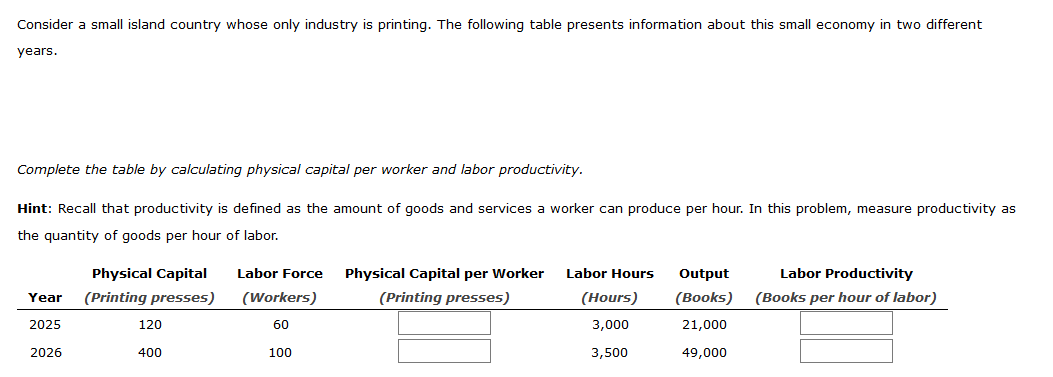Consider a small island country whose only industry is printing. The following table presents information about this small economy in two different years. Complete the table by calculating physical capital per worker and labor productivity. Hint: Recall that productivity is defined as the amount of goods and services a worker can produce per hour. In this problem, measure productivity as the quantity of goods per hour of labor. Physical Capital Labor Force Physical Capital per Worker Labor Hours Output Labor Productivity Year (Printing presses) (Workers) (Printing presses) (Hours) (Books) (Books per hour of labor) 2025 120 60 3,000 21,000 2026 400 100 3,500 49,000
Consider a small island country whose only industry is printing. The following table presents information about this small economy in two different years. Complete the table by calculating physical capital per worker and labor productivity. Hint: Recall that productivity is defined as the amount of goods and services a worker can produce per hour. In this problem, measure productivity as the quantity of goods per hour of labor. Physical Capital Labor Force Physical Capital per Worker Labor Hours Output Labor Productivity Year (Printing presses) (Workers) (Printing presses) (Hours) (Books) (Books per hour of labor) 2025 120 60 3,000 21,000 2026 400 100 3,500 49,000
Principles of Economics 2e
2nd Edition
ISBN:9781947172364
Author:Steven A. Greenlaw; David Shapiro
Publisher:Steven A. Greenlaw; David Shapiro
Chapter20: Economic Growth
Section: Chapter Questions
Problem 34P: Say that the average worker in Canada has a productivity level of 30 per hour while the average...
Related questions
Question
Consider a small island country whose only industry is printing. The following table presents information about this small economy in two different years.
Complete the table by calculating physical capital per worker and labor productivity.
Hint: Recall that productivity is defined as the amount of goods and services a worker can produce per hour. In this problem, measure productivity as the quantity of goods per hour of labor.

Transcribed Image Text:Consider a small island country whose only industry is printing. The following table presents information about this small economy in two different
years.
Complete the table by calculating physical capital per worker and labor productivity.
Hint: Recall that productivity is defined as the amount of goods and services a worker can produce per hour. In this problem, measure productivity as
the quantity of goods per hour of labor.
Physical Capital
Labor Force
Physical Capital per Worker
Labor Hours
Output
Labor Productivity
Year
(Printing presses)
(Workers)
(Printing presses)
(Hours)
(Books)
(Books per hour of labor)
2025
120
60
3,000
21,000
2026
400
100
3,500
49,000
Expert Solution
This question has been solved!
Explore an expertly crafted, step-by-step solution for a thorough understanding of key concepts.
This is a popular solution!
Trending now
This is a popular solution!
Step by step
Solved in 2 steps

Knowledge Booster
Learn more about
Need a deep-dive on the concept behind this application? Look no further. Learn more about this topic, economics and related others by exploring similar questions and additional content below.Recommended textbooks for you

Principles of Economics 2e
Economics
ISBN:
9781947172364
Author:
Steven A. Greenlaw; David Shapiro
Publisher:
OpenStax

Exploring Economics
Economics
ISBN:
9781544336329
Author:
Robert L. Sexton
Publisher:
SAGE Publications, Inc


Principles of Economics 2e
Economics
ISBN:
9781947172364
Author:
Steven A. Greenlaw; David Shapiro
Publisher:
OpenStax

Exploring Economics
Economics
ISBN:
9781544336329
Author:
Robert L. Sexton
Publisher:
SAGE Publications, Inc


Essentials of Economics (MindTap Course List)
Economics
ISBN:
9781337091992
Author:
N. Gregory Mankiw
Publisher:
Cengage Learning

Brief Principles of Macroeconomics (MindTap Cours…
Economics
ISBN:
9781337091985
Author:
N. Gregory Mankiw
Publisher:
Cengage Learning